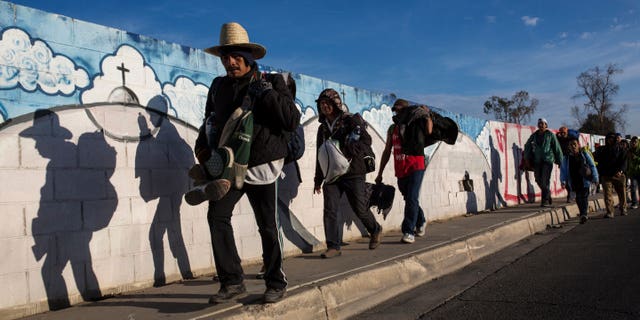Report:
Caravan migrants plan 'human stampede'

What recourse does the Trump administration have to protect the border? Conservative columnist Ann Coulter and immigration attorney Allen Orr weigh in.

What recourse does the Trump administration have to protect the border? Conservative columnist Ann Coulter and immigration attorney Allen Orr weigh in.
21 November, 2018
Some
members of the migrant caravan, who have spent the past month
traveling from Central America through Mexico to reach the U.S.
border, are talking about crossing the border en masse as a way to
provoke the Trump administration, an aid group has claimed.
"They
have that intention,” Sergio Tamai, a founder of Angels without
Borders, a group helping the migrants, told
Telemundo 20 in
San Diego. “I believe that thousands could make that jump."
At
least 3,000 migrants have already arrived in Tijuana, a border city
across from San Diego, Calif., the past two weeks. The federal
government estimates the number of migrants could grow to 10,000 in
the coming weeks, or months.
Those
already in the city have camped out in tents, slept on dirt fields or
under bleachers or are staying in overcrowded shelters throughout the
city as they wait to figure out their next steps.
But
some are growing impatient, and believe their best option is to plan
a mass crossing.
“Most
of us, yes, we want to be on the other side,” Jorge Molina, a
Honduran migrant, told Telemundo.
“Some want to jump over the wall, others to go another way, and
others want to wait and see what kind of response they get.”
Border
agents have already arrested dozens of
migrants trying to illegally cross the border.
About
5,800 active-duty troops dispatched to the border to deal with the
migrant crisis started coming home this week. On Monday, a judge
barred the president from enforcing a ban on asylum for those
who cross the U.S. border illegally – a decision the administration
said would cause “countless illegal aliens to pour into our
country."

Central
American migrants wait to access to the shelter in Tijuana, Mexico,
Tuesday, Nov. 20, 2018. At least 3,000 migrants have arrived in
Tijuana and the federal government estimates the number of migrants
could grow to 10,000 in the coming weeks and months. (AP Photo/Ramon
Espinosa)
Tijuana
residents have not fully embraced members
of the caravan. During the weekend, about 500 residents protested the
migrants by marching to an outdoor sports complex where the migrants
were camped out, with protesters chanting: “Get out!” and “We
don’t want you here!”
While
the caravan members have concentrated in one area of the city, many
residents fear with the passage of time their presence will take its
toll and crime could go up. Since 2016, thousands of Haitians who
also tried to get to the U.S. ended up settling in the city, while,
at the same time, Tijuana has taken in thousands of Mexicans deported
from the United States.
Tijuana
also has been struggling with drug violence and some say they do not
want the caravan bringing more problems.
Officials
have said they
arrested 34 caravan members for
drug possession, public intoxication, disturbing the peace and
resisting police, and they would be deported to their home countries.
Tijuana
Mayor Juan Manuel Gastelum has made a point of saying the city is not
happy with the migrants who began arriving last week, and he compared
the Central American group unfavorably with about 3,000 Haitians who
ended up staying after their bid to reach the U.S. failed last year.

Migrants,
who are part of a Central American migrant caravan, leave Mexicali
for Tijuana, Mexico, Tuesday, Nov. 20, 2018. Tensions have built as
nearly 3,000 migrants from the caravan poured into Tijuana in recent
days after more than a month on the road. (AP Photo/Rodrigo Abd)
“The
Haitians arrived with their papers, with a clear vision,” Gastelum
said in an interview posted on the city’s Facebook page. They came
“in an orderly way, they never asked us for food or shelter,”
renting apartments and making their own food. He said the Haitians
found jobs and “inserted themselves in the city’s economy” and
had not been involved in any disturbances.
By
contrast, Gastelum said, the caravan of Central Americans, “had
arrived all of sudden, with a lot of people — not all ... but a lot
— were aggressive and cocky.”
Tijuana
councilman Manuel Monárrez said a mass border would further strain
economic relations with the U.S.
"A
human stampede would be an immediate provocation to the U.S.,” said
Manuel Monárrez, a Tijuana councilman, told Telemundo. “And
justify [President] Donald Trump to impact the binational dynamics of
the economy.”
The
Associated Press contributed to this report
If you want the CNN side of the story...
#
 cartoon: The original migrant caravan...
cartoon: The original migrant caravan...
No comments:
Post a Comment
Note: only a member of this blog may post a comment.